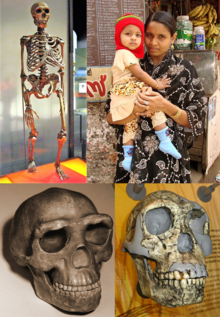| Homo Temporal range: Piacenzian - present,
| |
|---|---|

| |
| Notable members of Homo. Clockwise from top left: A reconstructed Neanderthal (Homo neanderthalensis) skeleton, a modern human (Homo sapiens) female with a child in India, a reconstructed Homo habilis skull, and a replica skull of Peking Man (subspecies of Homo erectus). | |
| Scientific classification | |
| Domain: | Eukaryota |
| Kingdom: | Animalia |
| Phylum: | Chordata |
| Class: | Mammalia |
| Order: | Primates |
| Suborder: | Haplorhini |
| Infraorder: | Simiiformes |
| Family: | Hominidae |
| Subfamily: | Homininae |
| Tribe: | Hominini |
| Subtribe: | Hominina |
| Genus: | Homo Linnaeus, 1758 |
| Type species | |
| Homo sapiens Linnaeus, 1758
| |
| Species | |
For other species or subspecies suggested, see below. | |
| Synonyms | |
|
Synonyms
| |
Homo (from Latin homō 'human') is a genus of great ape (family Hominidae) that emerged from the genus Australopithecus and encompasses only a single extant species, Homo sapiens (modern humans), along with a number of extinct species (collectively called archaic humans) classified as either ancestral or closely related to modern humans; these include Homo erectus and Homo neanderthalensis. The oldest member of the genus is Homo habilis, with records of just over 2 million years ago.[a] Homo, together with the genus Paranthropus, is probably most closely related to the species Australopithecus africanus within Australopithecus.[4] The closest living relatives of Homo are of the genus Pan (chimpanzees and bonobos), with the ancestors of Pan and Homo estimated to have diverged around 5.7-11 million years ago during the Late Miocene.[5]
H. erectus appeared about 2 million years ago and spread throughout Africa (debatably as another species called Homo ergaster) and Eurasia in several migrations. The species was adaptive and successful, and persisted for more than a million years before gradually diverging into new species around 500,000 years ago.[b][6]
Anatomically modern humans (H. sapiens) emerged close to 300,000 to 200,000 years ago[7] in Africa, and H. neanderthalensis emerged around the same time in Europe and Western Asia. H. sapiens dispersed from Africa in several waves, from possibly as early as 250,000 years ago, and certainly by 130,000 years ago, with the so-called Southern Dispersal, beginning about 70–50,000 years ago,[8][9][10] leading to the lasting colonisation of Eurasia and Oceania by 50,000 years ago. H. sapiens met and interbred with archaic humans in Africa and in Eurasia.[11][12] Separate archaic (non-sapiens) human species including Neanderthals are thought to have survived until around 40,000 years ago.
- ^ Stringer, C.B. (1994). "Evolution of early humans". In Jones, S.; Martin, R.; Pilbeam, D. (eds.). The Cambridge Encyclopedia of Human Evolution. Cambridge: Cambridge University Press. p. 242.
- ^ Schrenk, F.; Kullmer, O.; Bromage, T. (2007). "Chapter 9: The Earliest Putative Homo Fossils". In Henke, W.; Tattersall, I. (eds.). Handbook of Paleoanthropology. pp. 1611–1631. doi:10.1007/978-3-540-33761-4_52.
- ^ Spoor, F.; Gunz, P.; Neubauer, S.; Stelzer, S.; Scott, N.; Kwekason, A.; Dean, M.C. (March 2015). "Reconstructed Homo habilis type OH 7 suggests deep-rooted species diversity in early Homo". Nature. 519 (7541): 83–86. Bibcode:2015Natur.519...83S. doi:10.1038/nature14224. PMID 25739632. S2CID 4470282.
- ^ Haile-Selassie Y, Gibert L, Melillo SM, Ryan TM, Alene M, Deino A, et al. (May 2015). "New species from Ethiopia further expands Middle Pliocene hominin diversity". Nature. 521 (7553): 483–8. Bibcode:2015Natur.521..483H. doi:10.1038/nature14448. PMID 26017448. S2CID 4455029.
- ^ Foley, Robert A.; Mirazón Lahr, Marta (January 2024). "Ghosts of extinct apes: genomic insights into African hominid evolution". Trends in Ecology & Evolution. 39 (5): 456–466. Bibcode:2024TEcoE..39..456F. doi:10.1016/j.tree.2023.12.009. PMID 38302324.
- ^ a b Indriati E, Swisher CC, Lepre C, Quinn RL, Suriyanto RA, Hascaryo AT, et al. (2011). "The age of the 20 meter Solo River terrace, Java, Indonesia and the survival of Homo erectus in Asia". PLOS One. 6 (6): e21562. Bibcode:2011PLoSO...621562I. doi:10.1371/journal.pone.0021562. PMC 3126814. PMID 21738710..
- ^ Callaway, E. (7 June 2017). "Oldest Homo sapiens fossil claim rewrites our species' history". Nature. doi:10.1038/nature.2017.22114. Retrieved 11 June 2017.
- ^ Posth C, Renaud G, Mittnik A, Drucker DG, Rougier H, Cupillard C, et al. (March 2016). "Pleistocene Mitochondrial Genomes Suggest a Single Major Dispersal of Non-Africans and a Late Glacial Population Turnover in Europe". Current Biology. 26 (6): 827–33. Bibcode:2016CBio...26..827P. doi:10.1016/j.cub.2016.01.037. hdl:2440/114930. PMID 26853362. S2CID 140098861.
- ^ See:
- Karmin M, Saag L, Vicente M, Wilson Sayres MA, Järve M, Talas UG, et al. (April 2015). "A recent bottleneck of Y chromosome diversity coincides with a global change in culture". Genome Research. 25 (4): 459–66. doi:10.1101/gr.186684.114. PMC 4381518. PMID 25770088.
- Pagani L, Lawson DJ, Jagoda E, Mörseburg A, Eriksson A, Mitt M, et al. (October 2016). "Genomic analyses inform on migration events during the peopling of Eurasia". Nature. 538 (7624): 238–242. Bibcode:2016Natur.538..238P. doi:10.1038/nature19792. PMC 5164938. PMID 27654910.
- ^ Haber M, Jones AL, Connell BA, Arciero E, Yang H, Thomas MG, et al. (August 2019). "A Rare Deep-Rooting D0 African Y-Chromosomal Haplogroup and Its Implications for the Expansion of Modern Humans Out of Africa". Genetics. 212 (4): 1421–1428. doi:10.1534/genetics.119.302368. PMC 6707464. PMID 31196864.
- ^ Green RE, Krause J, Briggs AW, Maricic T, Stenzel U, Kircher M, et al. (May 2010). "A draft sequence of the Neandertal genome". Science. 328 (5979): 710–722. Bibcode:2010Sci...328..710G. doi:10.1126/science.1188021. PMC 5100745. PMID 20448178.
- ^ Lowery RK, Uribe G, Jimenez EB, Weiss MA, Herrera KJ, Regueiro M, Herrera RJ (November 2013). "Neanderthal and Denisova genetic affinities with contemporary humans: introgression versus common ancestral polymorphisms". Gene. 530 (1): 83–94. doi:10.1016/j.gene.2013.06.005. PMID 23872234. This study raises the possibility of observed genetic affinities between archaic and modern human populations being mostly due to common ancestral polymorphisms.
Cite error: There are <ref group=lower-alpha> tags or {{efn}} templates on this page, but the references will not show without a {{reflist|group=lower-alpha}} template or {{notelist}} template (see the help page).